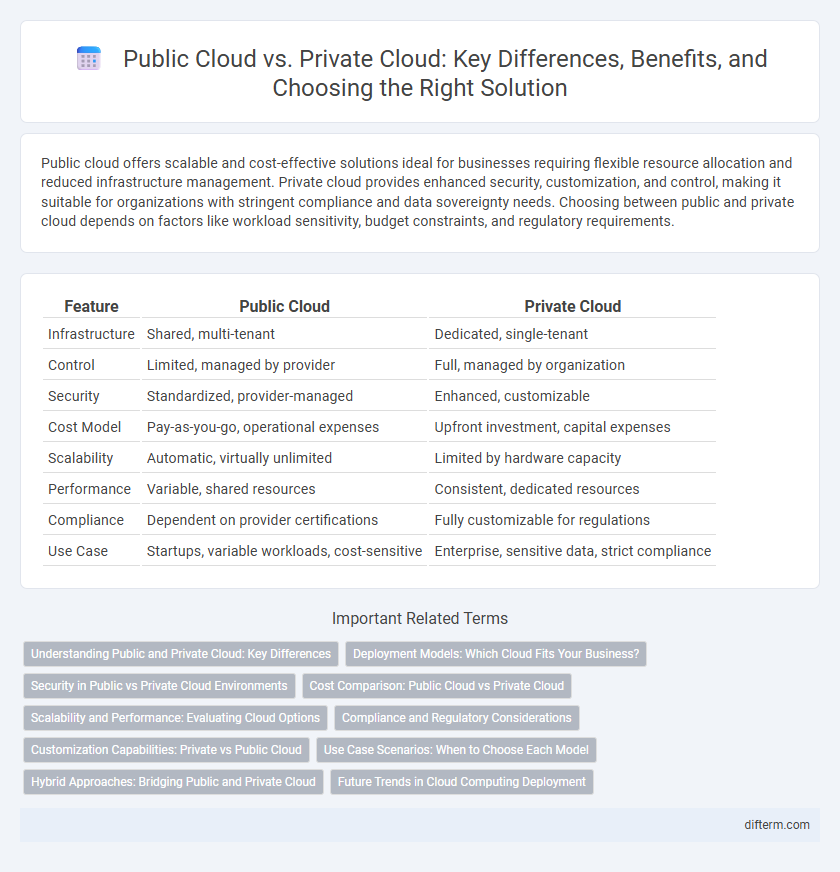Public cloud offers scalable and cost-effective solutions ideal for businesses requiring flexible resource allocation and reduced infrastructure management. Private cloud provides enhanced security, customization, and control, making it suitable for organizations with stringent compliance and data sovereignty needs. Choosing between public and private cloud depends on factors like workload sensitivity, budget constraints, and regulatory requirements.
Table of Comparison
| Feature | Public Cloud | Private Cloud |
|---|---|---|
| Infrastructure | Shared, multi-tenant | Dedicated, single-tenant |
| Control | Limited, managed by provider | Full, managed by organization |
| Security | Standardized, provider-managed | Enhanced, customizable |
| Cost Model | Pay-as-you-go, operational expenses | Upfront investment, capital expenses |
| Scalability | Automatic, virtually unlimited | Limited by hardware capacity |
| Performance | Variable, shared resources | Consistent, dedicated resources |
| Compliance | Dependent on provider certifications | Fully customizable for regulations |
| Use Case | Startups, variable workloads, cost-sensitive | Enterprise, sensitive data, strict compliance |
Understanding Public and Private Cloud: Key Differences
Public cloud offers scalable resources managed by third-party providers, enabling cost-efficient access to computing, storage, and networking without the need for on-premises infrastructure. Private cloud provides dedicated environments hosted either on-premises or by a single provider, ensuring enhanced security, compliance, and control for sensitive data. Key differences include cost structure, security levels, customization, and maintenance responsibilities, crucial for organizations when choosing the right cloud deployment model.
Deployment Models: Which Cloud Fits Your Business?
Public cloud deployment offers scalable infrastructure managed by third-party providers like AWS, Azure, and Google Cloud, making it ideal for businesses seeking cost-effective, on-demand resources without the need for extensive in-house IT maintenance. Private cloud environments deliver dedicated hardware and enhanced security tailored for organizations with strict data compliance requirements and sensitive workloads, offering more control over customization and governance. Hybrid cloud models combine both public and private clouds, enabling businesses to leverage flexibility and scalability while maintaining critical operations on private infrastructure.
Security in Public vs Private Cloud Environments
Public cloud environments often implement robust, multi-layered security protocols managed by specialized providers, ensuring rapid patch management and compliance with global standards such as ISO 27001 and SOC 2. Private cloud deployments offer enhanced control over security configurations, enabling customizable firewalls, encryption, and access management tailored to specific organizational policies and regulatory requirements. The choice between public and private cloud security depends on factors like data sensitivity, compliance mandates, and the organization's ability to manage security infrastructure effectively.
Cost Comparison: Public Cloud vs Private Cloud
Public cloud services typically offer lower upfront costs due to shared infrastructure and pay-as-you-go pricing models, making them cost-effective for businesses with fluctuating workloads. Private cloud deployments require significant capital investment in hardware, software, and maintenance, but provide predictable expenses and greater control over security and compliance. Total cost of ownership (TCO) varies based on factors like scalability, workload consistency, and data sovereignty requirements, influencing the choice between public and private cloud solutions.
Scalability and Performance: Evaluating Cloud Options
Public cloud services offer vast scalability through elastic resource allocation, enabling businesses to handle fluctuating workloads efficiently without upfront infrastructure investment. Private cloud environments provide customizable performance optimization tailored to specific organizational needs, ensuring consistent and secure compute resources. Evaluating scalability and performance requires analyzing workload patterns, data sensitivity, and long-term growth projections to determine the optimal cloud deployment model.
Compliance and Regulatory Considerations
Public cloud solutions offer scalable infrastructure but require rigorous compliance measures to meet industry regulations like GDPR, HIPAA, or PCI DSS, necessitating shared responsibility models for data security. Private clouds provide greater control over data governance and regulatory adherence, enabling customized compliance protocols tailored to specific organizational requirements. Organizations must assess the regulatory landscape and data sensitivity to select between public cloud flexibility and private cloud's enhanced compliance capabilities.
Customization Capabilities: Private vs Public Cloud
Private cloud environments provide extensive customization capabilities, allowing organizations to tailor infrastructure, security protocols, and applications to specific business requirements. Public clouds, while offering scalable and cost-effective solutions, limit customization due to shared resources and standardized configurations. Enterprises with stringent compliance and unique operational needs often prefer private clouds for greater control and flexibility.
Use Case Scenarios: When to Choose Each Model
Public cloud is ideal for startups and small businesses seeking scalable resources with lower upfront costs, perfect for applications with variable workloads and global reach. Private cloud suits enterprises requiring stringent security, regulatory compliance, and full control over hardware, often used in finance, healthcare, and government sectors. Hybrid models combine both, optimizing performance and cost-efficiency for complex use cases involving sensitive data and high-demand public services.
Hybrid Approaches: Bridging Public and Private Cloud
Hybrid cloud combines the scalability and cost-efficiency of public clouds with the security and control of private clouds, enabling seamless data and application portability across environments. Enterprises leverage hybrid cloud to optimize resource allocation, enhance disaster recovery, and maintain compliance with data sovereignty regulations. Advanced orchestration tools and APIs facilitate integrated management and automation, driving agility and operational efficiency in hybrid cloud deployments.
Future Trends in Cloud Computing Deployment
Public cloud adoption is projected to grow at a CAGR of 22% through 2028, driven by scalable infrastructure and cost-efficiency for enterprises. Private cloud deployment is evolving with enhanced security protocols and hybrid cloud models integrating AI-powered automation for optimized resource management. Edge computing and 5G connectivity will further influence cloud strategies, enabling low-latency access and real-time data processing across both public and private cloud environments.
Public Cloud vs Private Cloud Infographic

 difterm.com
difterm.com